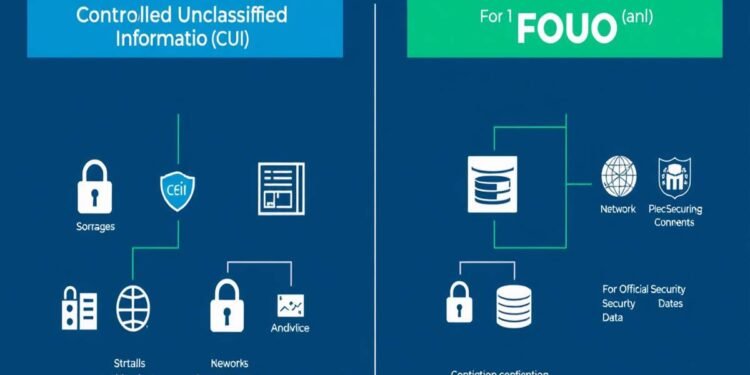Contracts can look pretty straightforward—until you get to the fine print. For subcontractors supporting federal projects, that fine print often includes CMMC flow-down clauses that carry real weight. These requirements aren’t just boxes to check; they’re responsibilities that directly impact how Controlled Unclassified Information (CUI) and Federal Contract Information (FCI) are handled across the supply chain.
How Do Flow-Down Clauses Strengthen Supply Chain Security?
Flow-down clauses work like a security net, stretching the protective reach of CMMC requirements beyond just the primary contractor. When federal contracts involve sensitive data, such as CUI and FCI, the risk doesn’t stop at the top. Every link in the chain needs to meet a baseline of cybersecurity expectations to keep the whole operation secure. That’s where flow-down clauses come in—they extend those same CMMC compliance requirements to subcontractors, no matter how small their role may seem.
This isn’t about overreach; it’s about keeping data from slipping through the cracks. If a prime contractor meets all CMMC level 2 requirements, but a subcontractor doesn’t, the vulnerability still exists. Flow-down language closes that gap. It turns cybersecurity from an individual task into a shared responsibility across the supply chain. Every subcontractor becomes part of the broader defense against threats, which ultimately makes the entire system more resilient.
Ensuring Subcontractor Accountability through Enforceable CMMC Provisions
Subcontractors don’t always realize the depth of their responsibilities until contract obligations spell them out. When CMMC provisions are clearly outlined through flow-down clauses, there’s less room for confusion and more focus on action. These clauses give prime contractors a formal way to hold subcontractors accountable for maintaining required cybersecurity standards—especially when CUI or FCI is involved.
By tying CMMC compliance requirements directly into subcontracts, primes create a binding agreement that can’t be ignored. It pushes subcontractors to conduct self-assessments, document their posture, and prepare for third-party CMMC assessments if needed. Without that enforceable language, some companies may delay or neglect building the proper controls, exposing the entire contract to unnecessary risk. Clear terms level the playing field and make expectations visible from day one.
Why Flow-Down Requirements Are Critical for Subcontractor Risk Mitigation
Handling government-related data without meeting CMMC level 1 or CMMC level 2 requirements isn’t just risky—it’s a liability. Flow-down clauses help subcontractors get ahead of that risk by requiring compliance from the outset. They encourage businesses to proactively assess where they stand and close any gaps before those weaknesses become problems during performance or audit.
For smaller subcontractors, the biggest hurdle is often not knowing what’s expected. Flow-down provisions force that conversation early, helping them understand what type of data they’ll be handling and what security level applies. If CUI is in play, then CMMC level 2 requirements kick in. If it’s only FCI, level 1 might be enough. These distinctions matter. Subcontractors that take time to meet the right standards reduce the likelihood of breaches, failed audits, or contract delays—all of which can be costly and damaging.
Integrating CMMC Flow-Down Policies for Enhanced CUI Protection
Controlled Unclassified Information deserves more than a lock and key. The government has made it clear that CUI protection is a priority, and that expectation doesn’t stop with prime contractors. Flow-down policies ensure that every subcontractor with access to CUI is operating under the same cybersecurity playbook. This uniformity helps prevent inconsistent controls that could expose sensitive data.
To make it work, primes and subs need to communicate openly. Integration doesn’t just mean inserting a clause into a contract—it means building shared protocols, verifying control implementations, and coordinating incident response plans. A subcontractor that handles CUI but isn’t aligned with CMMC requirements becomes a blind spot. With proper flow-down implementation, those blind spots disappear. Everyone involved knows the role they play in protecting data—and how to do it right.
What Impact Do Flow-Down Standards Have on FCI Handling Practices?
FCI might not get the same spotlight as CUI, but it’s still sensitive information that needs protecting. Flow-down standards help subcontractors recognize that FCI isn’t just “general business info.” It’s protected data that demands a baseline of security—specifically, adherence to CMMC level 1 requirements. Without clear flow-down guidance, it’s easy for subcontractors to overlook these expectations or assume their practices are sufficient.
With flow-down clauses in place, subcontractors become more intentional about their FCI handling. That means controlling access, using secure systems, and documenting internal practices. These aren’t optional anymore—they’re required. The impact is tangible: more consistent cybersecurity practices across the supply chain and fewer surprises when it comes time for a CMMC assessment. For subcontractors, that clarity can be the difference between passing a review or getting flagged for non-compliance.
Aligning Prime and Subcontractor Cybersecurity Postures via Flow-Down Compliance
Alignment between prime and subcontractor security postures isn’t just ideal—it’s necessary. One weak link can undermine even the most secure system. Flow-down clauses ensure that subcontractors are held to the same cybersecurity standards as the primes they support. This alignment keeps everyone focused on a shared outcome: protecting government data and maintaining contract eligibility.
That alignment also makes audits and assessments smoother. When subcontractors follow the same framework as primes, documentation, policies, and evidence are easier to review. Whether it’s a self-assessment or an official CMMC assessment, everyone is speaking the same language. Flow-down compliance builds trust, reduces gaps, and streamlines collaboration between all parties involved. It turns cybersecurity from a burden into a business asset that keeps contracts running and reputations intact.
Feel free to publish your content on Meedium and Professional SEO Services and Branding Services in Ahmedabad.





















